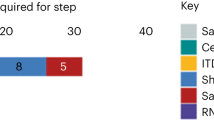Abstract
The analytical accuracy of the RIDASCREEN Norovirus 3rd Generation ELISA assay and the rapid immunochromatographic RIDAQUICK Norovirus assay were determined in comparison to PCR. In a prospective study 410 consecutive samples were collected from inpatients of a tertiary care hospital in Germany. All samples were tested with the two antigen detection assays, as well as with three different real-time reverse transcription PCR methods as the reference standard. A sample was considered true-positive if at least 2 out of 3 PCR methods yielded a positive signal (137 positive samples, >99% genogroup II). Compared with the PCR-based reference the overall diagnostic sensitivities of the ELISA and the immunochromatographic assay were 77% and 69% and the diagnostic specificities were 96% and 97% respectively. Both assays allow the rapid and economic screening of large numbers of samples and thus are useful diagnostic tools for the detection of suspected norovirus infections.

Similar content being viewed by others
References
Atmar RL, Estes MK (2006) The epidemiologic and clinical importance of norovirus infection. Gastroenterol Clin North Am 35 (2):275–290, viii. doi:10.1016/j.gtc.2006.03.001
Johnston CP, Qiu H, Ticehurst JR, Dickson C, Rosenbaum P, Lawson P, Stokes AB, Lowenstein CJ, Kaminsky M, Cosgrove SE, Green KY, Perl TM (2007) Outbreak management and implications of a nosocomial norovirus outbreak. Clin Infect Dis 45(5):534–540. doi:10.1086/520666
Gray JJ, Kohli E, Ruggeri FM, Vennema H, Sanchez-Fauquier A, Schreier E, Gallimore CI, Iturriza-Gomara M, Giraudon H, Pothier P, Di Bartolo I, Inglese N, de Bruin E, van der Veer B, Moreno S, Montero V, de Llano MC, Hohne M, Diedrich SM (2007) European multicenter evaluation of commercial enzyme immunoassays for detecting norovirus antigen in fecal samples. Clin Vaccine Immunol 14(10):1349–1355. doi:10.1128/cvi.00214-07
Hoehne M, Schreier E (2006) Detection of Norovirus genogroup I and II by multiplex real-time RT- PCR using a 3′-minor groove binder-DNA probe. BMC Infect Dis 6:69. doi:10.1186/1471-2334-6-69
Hilgers RA (1991) Distribution-free confidence bounds for ROC curves. Methods Inf Med 30(2):96–101
Kirby A, Gurgel RQ, Dove W, Vieira SC, Cunliffe NA, Cuevas LE (2010) An evaluation of the RIDASCREEN and IDEIA enzyme immunoassays and the RIDAQUICK immunochromatographic test for the detection of norovirus in faecal specimens. J Clin Virol 49(4):254–257. doi:10.1016/j.jcv.2010.08.004
Bruins MJ, Wolfhagen MJ, Schirm J, Ruijs GJ (2010) Evaluation of a rapid immunochromatographic test for the detection of norovirus in stool samples. Eur J Clin Microbiol Infect Dis 29(6):741–743. doi:10.1007/s10096-010-0911-5
Wilhelmi de Cal I, Revilla A, del Alamo JM, Roman E, Moreno S, Sanchez-Fauquier A (2007) Evaluation of two commercial enzyme immunoassays for the detection of norovirus in faecal samples from hospitalised children with sporadic acute gastroenteritis. Clin Microbiol Infect 13(3):341–343. doi:10.1111/j.1469-0691.2006.01594.x
Siebenga JJ, Vennema H, Zheng DP, Vinje J, Lee BE, Pang XL, Ho EC, Lim W, Choudekar A, Broor S, Halperin T, Rasool NB, Hewitt J, Greening GE, Jin M, Duan ZJ, Lucero Y, O’Ryan M, Hoehne M, Schreier E, Ratcliff RM, White PA, Iritani N, Reuter G, Koopmans M (2009) Norovirus illness is a global problem: emergence and spread of norovirus GII.4 variants, 2001–2007. J Infect Dis 200(5):802–812. doi:10.1086/605127
Amar CF, East CL, Gray J, Iturriza-Gomara M, Maclure EA, McLauchlin J (2007) Detection by PCR of eight groups of enteric pathogens in 4,627 faecal samples: re-examination of the English case-control Infectious Intestinal Disease Study (1993–1996). Eur J Clin Microbiol Infect Dis 26(5):311–323. doi:10.1007/s10096-007-0290-8
De Wit MA, Koopmans MP, Kortbeek LM, Wannet WJ, Vinje J, van Leusden F, Bartelds AI, van Duynhoven YT (2001) Sensor, a population-based cohort study on gastroenteritis in the Netherlands: incidence and etiology. Am J Epidemiol 154(7):666–674
Gallimore CI, Cubitt D, du Plessis N, Gray JJ (2004) Asymptomatic and symptomatic excretion of noroviruses during a hospital outbreak of gastroenteritis. J Clin Microbiol 42(5):2271–2274
Acknowledgements
We thank C. Döffinger (R-Biopharm AG) for discussing the manuscript.
Author information
Authors and Affiliations
Corresponding author
Additional information
Denise Kaiser and Sabrina Schrempf contributed equally
Rights and permissions
About this article
Cite this article
Geginat, G., Kaiser, D. & Schrempf, S. Evaluation of third-generation ELISA and a rapid immunochromatographic assay for the detection of norovirus infection in fecal samples from inpatients of a German tertiary care hospital. Eur J Clin Microbiol Infect Dis 31, 733–737 (2012). https://doi.org/10.1007/s10096-011-1366-z
Received:
Accepted:
Published:
Issue Date:
DOI: https://doi.org/10.1007/s10096-011-1366-z




